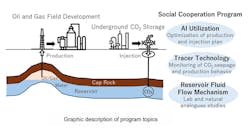DNV exec shares insights on challenges, path forward for offshore industry
By Ariana Hurtado, Editor and Director of Special Reports
Torgeir Sterri, DNV's senior vice president and director of offshore classification, recently gave a keynote address in October at DNV Technology Week in Katy, Texas, in which he focused on the energy transition and shared his positive outlook for the industry.
"While the world is in transition, we are just beginning our energy transition," he said. "It’s not an on/off switch, but a journey to find the right balance."
DNV has issued several industry reports this year covering topics such as AI, emissions and offshore wind. Sterri's team aims to ensure that offshore assets and operations are safe, reliable, compliant and meet the expectations of the offshore industry and its stakeholders.
Sterri recently shared his perspective with Offshore about the initiatives at the top of his list and what DNV will be focused on as we head into the new year.
"More broadly, the energy transition and the drive within the maritime world toward a low or zero carbon future remains at the top of everyone’s agenda," Sterri told Offshore. "But even with this focus, we need to meet our clients wherever they are in their decarbonization journey and support them toward their goals."
With more than 25 years of experience in the maritime industry, Sterri currently leads the company’s global maritime offshore classification business from its headquarters in Høvik, Norway. He has held a variety of leadership roles at DNV, including maritime regional manager for region West Europe as well as regional manager and chairman for Greater China.
He has a strong technical foundation in areas such as plan approval, ship newbuilding, ship operation, and certification of materials and components. He also brings hands-on maritime expertise, having served as a captain on ferries in Oslo. In addition, Sterri is a naval architect and a graduate of the Norwegian University of Science and Technology.
In the following Q&A, Sterri details the challenges the offshore energy sector is facing, how DNV is helping solve those issues and the path forward for the offshore oil and gas industry.
Offshore: For those not in attendance, what were the takeaways of your keynote at DNV Technology Week?
Sterri: To secure energy, we need three things: energy security, environmental sustainability and reasonably priced energy. This energy trilemma is a model that emphasizes the balance needed with all three to be successful. As an industry, we can learn from this model and look at how we can impact the outcome. By being a part of the green shift, maximize energy by minimizing emissions, and make the industry enticing of the next generation of driven and creative minds, we can contribute to progressing the transition.
I am positive about the future of our industry. We have a lot of knowledge and passion, and we have a new generation coming with fresh creative ideas that are more engaged than ever. As we attract and train this generation to the industry, we also bring in new ideas, refreshed passion, and more opportunities for innovation and collaboration. Together, we can tackle the challenges ahead.
Offshore: What are the most important issues for DNV Maritime as we head into 2025? Why?
Sterri: As an organization, we are continually working to empower our customers to meet the challenges they face—so their issues are our top issues. And you can’t get past the energy transition and the ongoing impact of greater digitalization on the industry.
On the energy transition, we’re on a journey, but it’s one where there are many different paths for our customers. There is no longer a “one size fits all" solution; we’re there to help find a balanced approach, one that incorporates both energy efficiency and the adoption of new technologies.
Digitalization is the key to unlocking many of the challenges we face in the shipping and offshore industries, including decarbonization. We have many of the tools we need already, like digital monitoring, collection, connected platforms, 3D models and simulations, but we need to accelerate their deployment, make sure they are frictionless to use, and train the people using them.
AI is going to be a real wild card, and I think it would be a real mistake to think that AI will have a limited impact on the maritime and offshore industries. The jumps these systems have taken in the last year or two are only likely to accelerate, and we could see big changes in everything from vessel design, autonomous vessels, maintenance, through to risk and supply chain management. These systems could take us in directions that we have not anticipated and realize incredible efficiencies and advancements.
Offshore: What are the top challenges in the offshore oil and gas industry? What can DNV do to help/affect those issues?
Sterri: The offshore segment is extremely complex and has the twin challenges of adapting to a world that is in an energy transition and looking to decarbonize, while deploying new digital technologies and systems that will enable the creation of new value propositions, business models and services. One of the things we are very proud of at DNV is our ability to leverage cross-sector expertise at a very deep level to help tackle these challenges.
Safety in the offshore sector has improved, but challenges remain. So, as we continue to move forward, we have to make sure we do not lose sight of safety. We need a holistic approach to ensure regulations are updated to match the pace of technological innovation. This requires continuous collaboration, not just within the industry, but also with wider stakeholders like governments, financial institutions, suppliers and the general public.
Cybersecurity is going to be one of the industry’s key safety issues over the next decade. Increasing connectivity and reliance on software, means of course that we are increasingly vulnerable to cyber attacks and are increasingly reliant on cybersecurity. Simulation-based test regimes like HIL [hardware in the loop] testing are one remedy, but more has to be done in order to create the same levels of assurance and performance as we are used to from analogue systems.
At DNV, cybersecurity has been part of our class scope for several years, now fully aligned with the new IACS Unified Requirements. We run webinars and trainings to boost competence, and with the acquisition of CyberOwl, NIXU and Applied Risk, we now have a 500-plus person cybersecurity team. Combined with our offshore knowledge, we can support our customers in building digital robustness and cybersecurity resilience into their design and operation.
Offshore: What's the path forward for the offshore oil and gas industry?
Sterri: The offshore oil and gas industry still has a big role to play, but we have to stay relevant and adapt to a business environment where decarbonization will be even more emphasized, digitalization will become even more important to unlock efficiencies, and competition for talent intensifies.
In the maritime world, we’ve seen a big shift toward alternative fuels, particularly LNG, so offshore gas will be essential to enabling this transition for those hard to decarbonize segments of the industry.
At the same time, we have to be aware of our own footprint as an industry, which is why we’ve been working with partners on initiatives like the Abate notation. This helps our customers deploy a structures approach to reducing emissions through implementing onboard abatement measures in power generation, fugitive emissions from process plant and storage tanks, and non-routine flaring.
The offshore industry is also experiencing a digital revolution, as new technologies and data-driven solutions enable new ways of working. Information security must become an integral part of daily operations—on board and at shore. Understanding what makes security arrangements robust and matching the complexity of assets is vital to keep smarter vessels and offshore units secure.
One upcoming sector that could play a big role going forward is carbon capture and storage [CCS]. CCS is needed wherever there are emissions, in both power generation, in industrial processes and potentially through onboard carbon capture in shipping. While the name of the game is to stop emitting CO2 to the atmosphere, as long as there are fossil fuels in the power mix, CCS is needed.
In addition, regulations like the EU Net Zero Industry Act (NZIA), which recently came into force, will spur development of this sector. The NZIA identifies CCS as a strategic net-zero technology, setting a target of 50 million tonnes of annual CO2 injection capacity by 2030 and mandating contributions from oil and gas companies.
The offshore sector's expertise in drilling and engineering can make a major contribution to the safety and efficiency of CCS operations. Offshore platforms also provide a unique opportunity for CCS due to their existing infrastructure, but they must be adapted for carbon storage. DNV aims to assist operators and authorities in developing and deploying sustainable CO2 storage solutions, utilizing best practices, to implement CCS technologies and meet critical climate targets.
Offshore: What advice would you give young professionals joining the industry or to someone debating the offshore oil and gas sector versus another industry?
Sterri: Firstly, that this is an exciting time to be a part of the offshore industry. We are experiencing significant technological advancements, particularly in areas such as digitalization, automation and the use of artificial intelligence.
The industry is also expanding and exploring innovative ways to utilize our core competencies, particularly in harnessing renewable energy in the ocean space. Beyond the growth of the offshore wind sector, which includes both bottom-fixed and floating wind farms, there are other exciting developments like offshore fish farms where the industry is leveraging its expertise. These farms are designed to cultivate fish in large, floating structures located in open-sea areas and equipped with advanced technologies for monitoring and managing fish health, water quality and feeding systems.
Ultimately, the offshore oil and gas sector offers diverse opportunities. By embracing innovation, prioritizing safety and staying adaptable, you can build a successful and impactful career in this industry.





